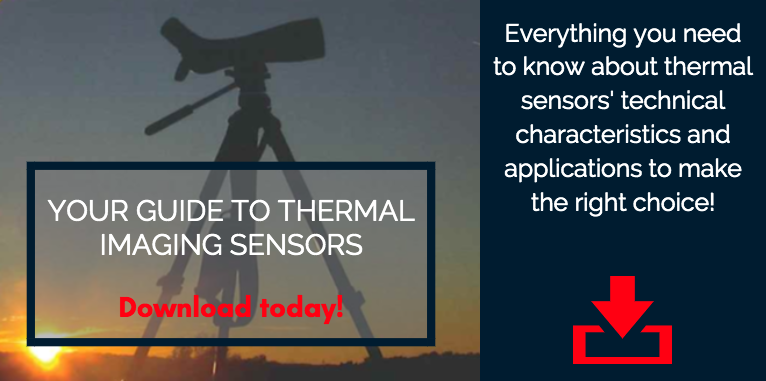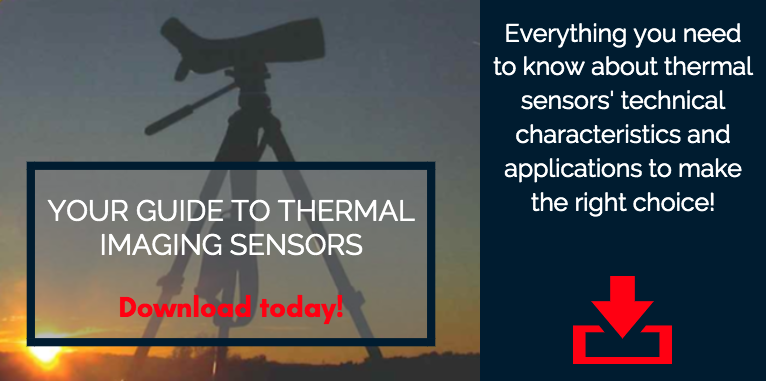Precision Thermal Imaging for Hunting & Leisure: Premium European Solutions for ...
The Hunting & Leisure market is evolving—driven by advanced technology, changing regulations, and the expectations of a new generation of responsible hunters...

September 04, 2019 . 5min read
Thermal sensors are gaining traction on a broad range of markets, from sports and leisure to automotive and defense. Thermal sensors are easy to use and—as their use become more widespread—less expensive. Thermal sensors offer advanced technical characteristics that are driving major changes in many fields.
And, due to its unique capabilities, thermal imaging technology is finding applications on a number of new markets.
Here are some thermal sensor characteristics and their most common uses :
1- Crisp, reliable images
Surveillance:
High-contrast thermal images can be used to effectively detect an intruder at night, even if the intruder is hidden in the shadows.
Police and other security forces can use thermal images to pursue suspects, even at night, never losing sight of the suspect.
Automotive:
Thermal imaging can be used to better see highway traffic, even at night, with the advantage of reduced headlight glare.
It can also make night driving safer and easier by helping drivers see obstacles in their paths more easily, avoiding potential hazards.
Finally, thermal imaging lets drivers see obstacles up to 100 meters away—a much greater distance than with their high beams. This makes night driving safer and reduces fatigue.
Defense:
Thermal imaging lets troops see their enemies just as clearly at night as during the day, even if they are camouflaged. Ground troops can also use thermal imaging to move around in hostile, unpredictable territory at night without using lights that risk revealing their positions.
2- Heat detection
Fire prevention:
One of the most useful applications for thermal imaging for firefighters is identifying hot zones before entering a burning building. More importantly, thermal imaging can be used to locate people in danger, ultimately saving lives.
Thermal imaging also makes firefighters’ work easier by helping them rapidly pinpoint locations where a fire is about to ignite, such as for brush or forest fires.
Industrial maintenance:
Thermal cameras can also be used to monitor high-risk equipment like circuit breakers, electricity meters, and high-voltage equipment like transformers, detecting any malfunctions before the equipment breaks down or overheats, for example.

Search and rescue:
Thermal imaging can help save lives by locating a missing person or person in danger in difficult-to-access areas like mountains, bodies of water, or thick forest. It can help save victims that never would have been found using traditional search techniques.
Building heat audits:
Identifying heat losses is one of the first steps toward improving a building’s energy efficiency and protecting the environment. Thermal imaging is an economical, future-proof solution for building heat audits.
Healthcare:
Thermal imaging can be used to detect abnormally-high temperatures—like in the case of a fever—and potential infections.
It can also detect painful inflammation during surgery or on a patient who is unconscious.
Outdoor:
Thermal imaging can be used by hunters during the day or at night to locate game.
It can also be used during survival courses for presence detection and night vision.
More generally, for nature lovers, thermal imaging makes it easier to observe plant and animal life at night—often the best time for an encounter with rare or difficult-to-approach species.
3 – Increasingly affordable costs
Everyday use:
Thermal cameras are of increasing interest to homeowners as a way to protect their homes and yards. Thermal sensor technology can also be used in home automation systems to manage lighting and heat—applications that are also becoming more common.
Thermal imaging is also becoming more common in automotive computers—a use that is limited to higher-end vehicles for now. Research and development are also underway to integrate thermal imaging into driverless cars.
As the number and variety of uses for thermal imaging increase, the technology will become more and more widespread. This is good news, as thermal imaging offers capabilities that align closely with tomorrow’s needs in areas from the home to healthcare and industry. Increasing use of the technology will bring costs down, making the technology even more accessible to users of all kinds.
If you would like to learn more about the thermal image sensors and their technical characteristics, download our free, practical guide to find out everything you need to know to use the technology.
